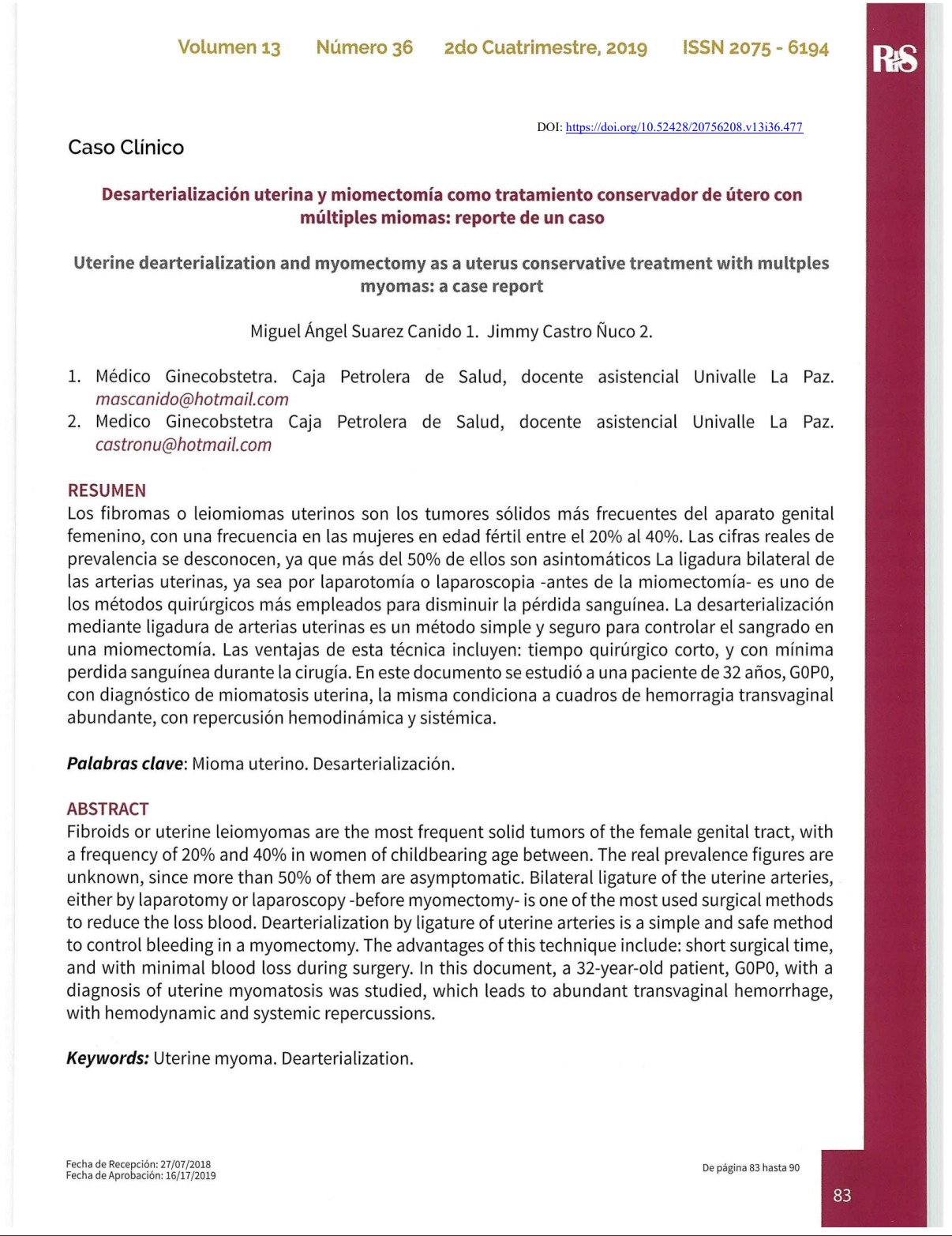Uterine dearterialization and myomectomy as a uterus conservative treatment with multples myomas: a case report
DOI:
https://doi.org/10.52428/20756208.v13i36.477Keywords:
Uterine myoma, DearterializationAbstract
Fibroids or uterine leiomyomas are the most frequent solid tumors of the female genital tract, with a frequency of 20% and 40% in women of childbearing age between. The real prevalence figures are unknown, since more than 50% of them are asymptomatic. Bilateral ligature of the uterine arteries, either by laparotomy or laparoscopy -before myomectomy- is one of the most used surgical methods to reduce the loss blood. Dearterialization by ligature of uterine arteries is a simple and safe method to control bleeding in a myomectomy. The advantages of this technique include: short surgical time, and with minimal blood loss during surgery. In this document, a 32-year-old patient, GOPO, with a diagnosis of uterine myomatosis was studied, which leads to abundant transvaginal hemorrhage, with hemodynamic and systemic repercussions.
Downloads
References
GARCIA-DE LA TORRE Jl , AGUIRRE-RAMOS MA , RAMOS-ALVARADO AM , VILLA-PONCE D , GONZÅLEZCANTU G. 2016. Miomectomia y desarterializaci6n uterina como tratamiento conservador de la miomatosis de grandes elementos: reporte de un caso. Ginecol Obstet Mex. feb;84(2):112-121.
EDWARDS RD, MOSS JG, LUMSDEN MA, et al. 2007. Uterine artery embolization versus surgery for symptomatic uterine fibroids. The REST committee. N Engl J Med;356:360-70.
ALBORZI S, GHANNADAN E, ALBORZI S, ALBORZI M. 2009. A comparison of combined laparoscopic uterine artery ligation and myomectomy versus laparoscopic myomectomy in treatment of symptomatic myoma. Fertil Steril;92(2):743-7.
DOUMOUCHTSIS SK, NIOLOPOULOS K, TALAULIKAR VS, KRISHNA A, ARULKUMARAN S. 2014. Menstrual and fertility outcomes following the surgical management of postpartum hemorrhage: a systematic review. BJOG;121:382-388.
CHANG KM, CHEN MJ, LEE MH, HUANG YD, CHEN CS. 2012. Fertility and pregnancy outcomes after uterine artery occlusion with or without myomectomy. Taiwan J Obstet Gynecol;51(3):331-5.
SANNE M, VAN DER KOOIJ MD A, B, WOUTER J.K, HEHENKAMP MD. 2010.Uterine artery embolization vs hysterectomy in the treatment of symptomatic uterine fibroids: 5-year outcome from the randomized EMMY trial. J Obstet Gynecol, Volume 203, Issue 2, August, Pages 105.e1-105.e13.
MARA M, MASKOVA J, FUCIKOVA Z, KUZEL D, et al. 2008. Midterm clinical and first reproductive results of a randomized controlled trial comparing uterine fibroid embolization and myomectomy. Cardiovasc Intervent Radiol;31(1):73
MARSHBURN PB, MATTHEWS ML, HURST BS. 2006. Uterine artery embolization as a treatment option for uterine myomas. Obstet Gynecol Clin North Am;33: 125-44
SOLEDAD LOYOLA Z. MARIO FAVA P. RODRIGO MACAYA P. 2007. Embolizaciön De Arterias Uterinas En El Tratamiento De Miomas Uterinos Sintomåticos. Rev Chil Obstet Ginecol 2007; 72(4): 236-240 REV CHIL OBSTET GINECOL•, 72(4).
PELAGE JP, LE DREF O, SOYER P, KARDACHE M, DAI-IAN H, ABITBOL M, et al. 2000. Fibroid-related menorrhagia: treatment with superselective embolization of the uterine arteries and midterm follow-up. Radiology; 215:428-31.

Downloads
Published
How to Cite
Issue
Section
License
Copyright (c) 2019 Miguel Ángel Suarez Canido y Jimmy Castro Ñuco

This work is licensed under a Creative Commons Attribution 4.0 International License.
Authors who publish with this journal agree to the following terms:
- Authors retain copyright and grant the journal right of first publication with the work simultaneously licensed under a Creative Commons Attribution License 4.0 that allows others to share the work with an acknowledgement of the work's authorship and initial publication in this journal.
- Authors are able to enter into separate, additional contractual arrangements for the non-exclusive distribution of the journal's published version of the work (e.g., post it to an institutional repository or publish it in a book), with an acknowledgement of its initial publication in this journal.
- Authors are permitted and encouraged to post their work online (e.g., in institutional repositories or on their website) prior to and during the submission process, as it can lead to productive exchanges, as well as earlier and greater citation of published work.






















